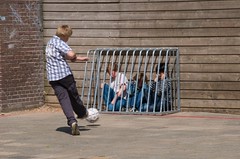A study commissioned by Anderson Cooper 360 found that the stereotype of schoolyard bullies preying on the weak doesn’t reflect reality. Instead, the Long Island-based study showed students are involved in a constant verbal, physical, and cyber fight to reach the top of the school hierarchy.
“Kids are caught up in patterns of cruelty and aggression that have to do with jockeying for status,” explains Robert Faris, a sociologist whom “Anderson Cooper 360°” partnered with for the pilot study. “It’s really not the kids that are psychologically troubled, who are on the margins or the fringes of the school’s social life. It’s the kids right in the middle, at the heart of things … often, typically highly, well-liked popular kids who are engaging in these behaviors.”
Faris and his co-author, Diane Felmlee, also found that “bullies” and “victims” aren’t defined roles and can in fact be the same person.
“When kids increase in their status, on average, they tend to have a higher risk of victimization as well as a higher risk of becoming aggressive,” Faris says.
Many of these results mirror results from an earlier study that Faris and Felmlee conducted in North Carolina. Based on such similar findings in such different locations, Faris noted,
“Family background of kids does not really seem to matter in their aggressive behavior. Instead, what really matters is where they are located in the school hierarchy”….The patterns, “arise in a wide range of schools across the country regardless of what community they may be in.”
Yet, the authors remained hopeful for two reasons. First, their study found that aggressive behavior does not actually elevate a child’s social status. Second, Faris thinks behavior is contagious.
When students are aggressive, there’s a higher likelihood that their friends will become aggressive. But Faris said, “there’s also the possibility that positive behaviors can also spread through social networks and that kids may be more likely to intervene in bullying situations if they see their friends stepping in to stop things, or if they see their friends discouraging that kind of behavior.”


Comments